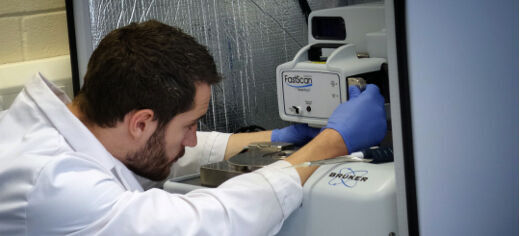
Scientists from the University of Leeds have taken a crucial step forward in bio-nanotechnology, a field that uses biology to develop new tools for science, technology and medicine.
The new study, published in print today in the journal Nano Letters, demonstrates how stable ‘lipid membranes’ – the thin ‘skin’ that surrounds all biological cells – can be applied to synthetic surfaces.
Importantly, the new technique can use these lipid membranes to ‘draw’ – akin to using them like a biological ink – with a resolution of 6 nanometres (6 billionths of a meter), which is much smaller than scientists had previously thought was possible.
“This is smaller than the active elements of the most advanced silicon chips and promises the ability to position functional biological molecules – such as those involved in taste, smell, and other sensory roles – with high precision, to create novel hybrid bio-electronic devices,” said Professor Steve Evans, from the School of Physics and Astronomy at the University of Leeds and a co-author of the paper.
In the study, the researchers used something called Atomic Force Microscopy (AFM), which is an imaging process that has a resolution down to only a fraction of a nanometer and works by scanning an object with a miniscule mechanical probe. AFM, however, is more than just an imaging tool and can be used to manipulate materials in order to create nanostructures and to ‘draw’ substances onto nano-sized regions. The latter is called ‘nano-lithography’ and was the technique used by Professor Evans and his team in this research.
The ability to controllably ‘write’ and ‘position’ lipid membrane fragments with such high precision was achieved by Mr George Heath, a PhD student from the School of Physics and Astronomy at the University of Leeds and the lead author of the research paper.
Mr Heath said: “The method is much like the inking of a pen. However, instead of writing with fluid ink, we allow the lipid molecules – the ink – to dry on the tip first. This allows us to then write underwater, which is the natural environment for lipid membranes. Previously, other research teams have focused on writing with lipids in air and they have only been able to achieve a resolution of microns, which is a thousand times larger than what we have demonstrated. “
The research is of fundamental importance in helping scientists understand the structure of proteins that are found in lipid membranes, which are called ‘membrane proteins’. These proteins act to control what can be let into our cells, to remove unwanted materials, and a variety of other important functions.
For example, we smell things because of membrane proteins called ‘olfactory receptors’, which convert the detection of small molecules into electrical signals to stimulate our sense of smell. And many drugs work by targeting specific membrane proteins.
“Currently, scientists only know the structure of a small handful of membrane proteins. Our research paves the way to understand the structure of the thousands of different types of membrane proteins to allow the development of many new drugs and to aid our understanding of a range of diseases,” explained Professor Evans.
Aside from biological applications, this area of research could revolutionise renewable energy production.
Working in collaboration with researchers at the University of Sheffield, Professor Evans and his team have all of the membrane proteins required to construct a fully working mimic of the way plants capture sunlight. Eventually, the researchers will be able to arbitrarily swap out the biological units and replace them with synthetic components to create a new generation of solar cells.
Professor Evans concludes: “This is part of the emerging field of synthetic biology, whereby engineering principles are being applied to biological parts – whether it is for energy capture, or to create artificial noses for the early detection of disease or simply to advise you that the milk in your fridge has gone off.
“The possibilities are endless.”
Further information
The research paper, 'Diffusion in Low-Dimensional Lipid Membranes', is published on 8 October 2014 in the journal Nano Letters. Access it here
This research was funded by the Engineering and Physical Sciences Research Council (EPSRC).
George Heath and Professor Steve Evans are available for interview. Please contact Sarah Reed, Press Officer at the University of Leeds, on 0113 34 34196 or email s.j.reed@leeds.ac.uk
Image
Caption: Mr George Heath setting up the Atomic Force Microscope, which sits on a vibration isolation table and is held within an acoustic hood to isolate external noise.
Credit: Mr George Heath
Image download: http://goo.gl/jb677k